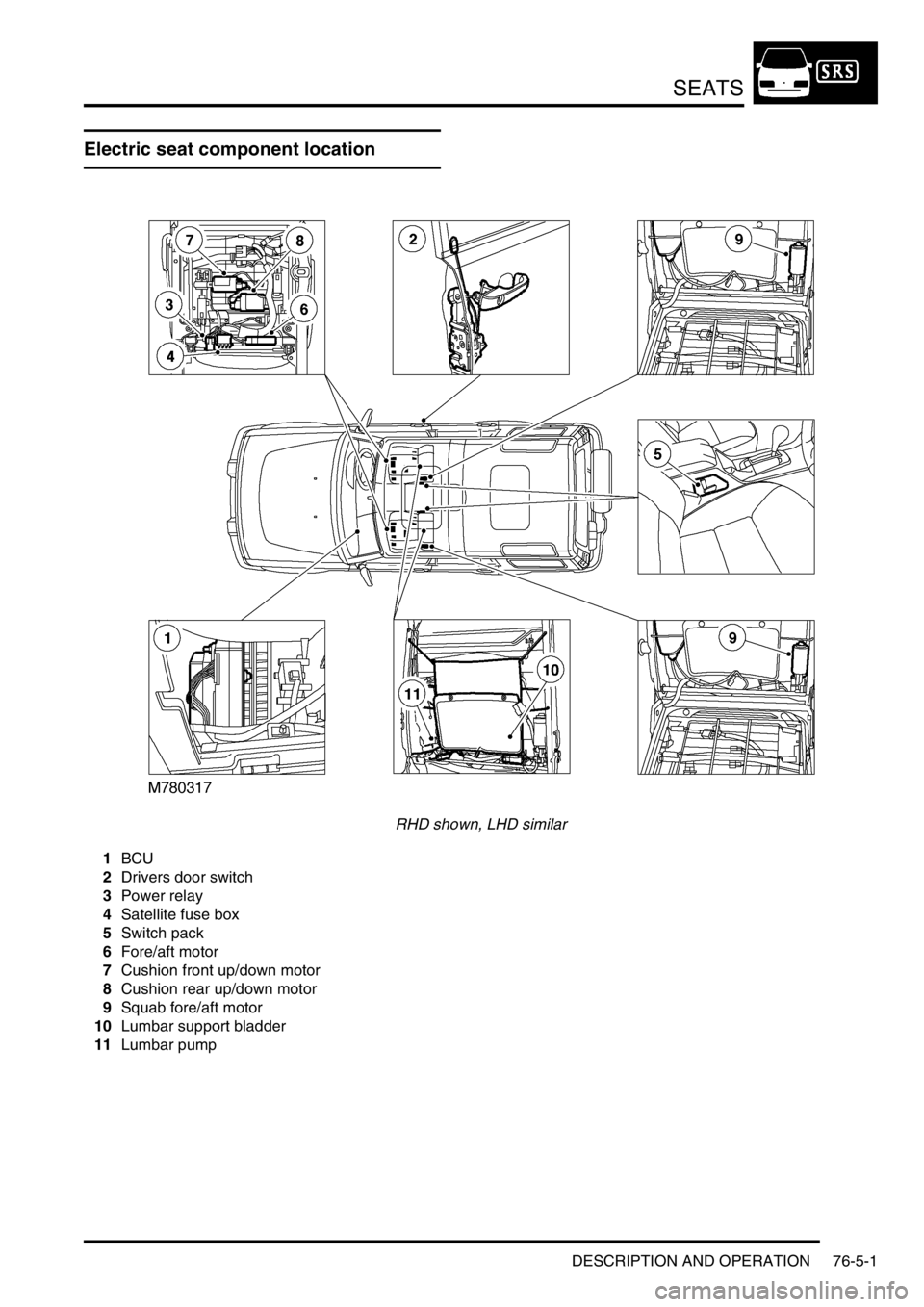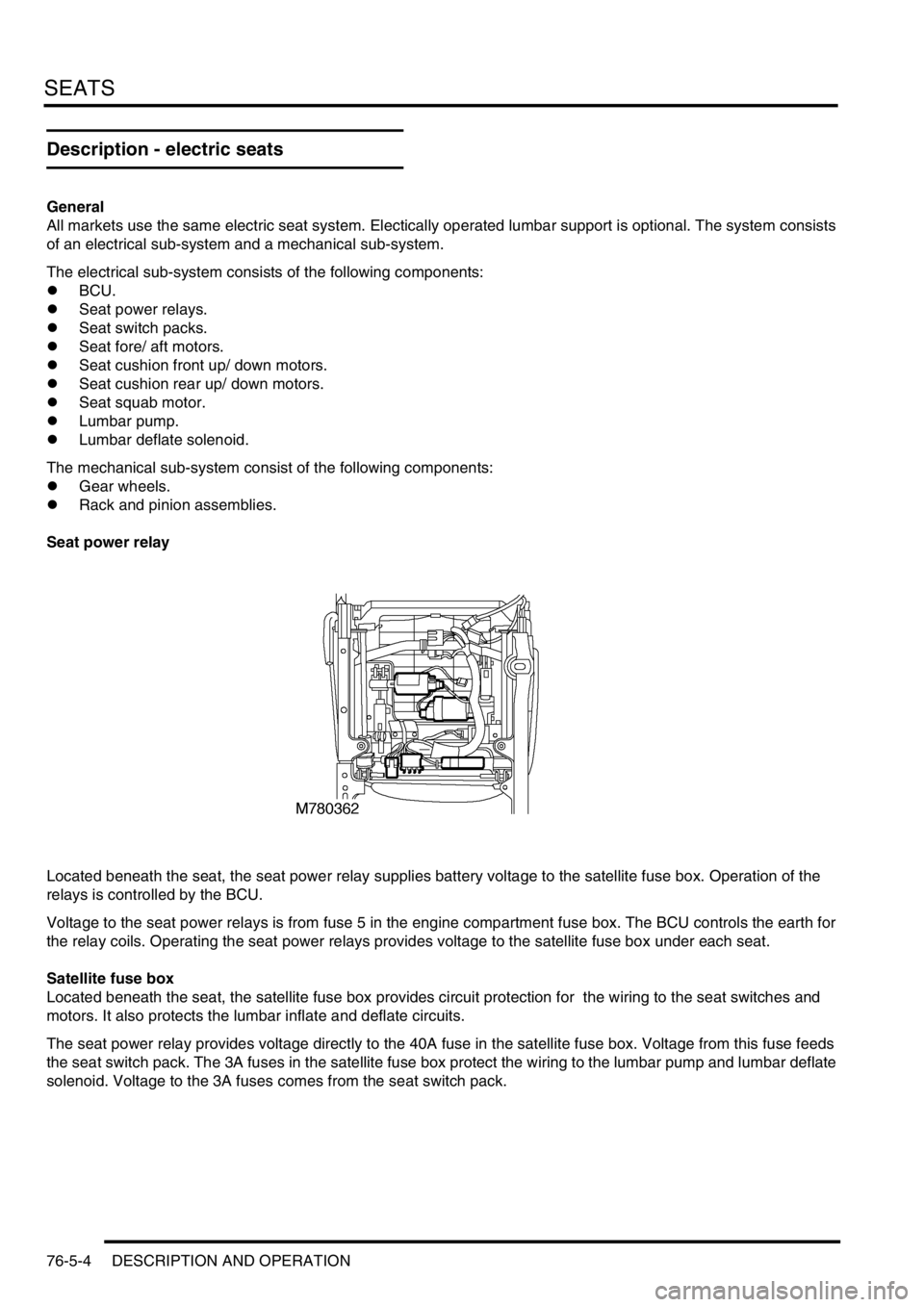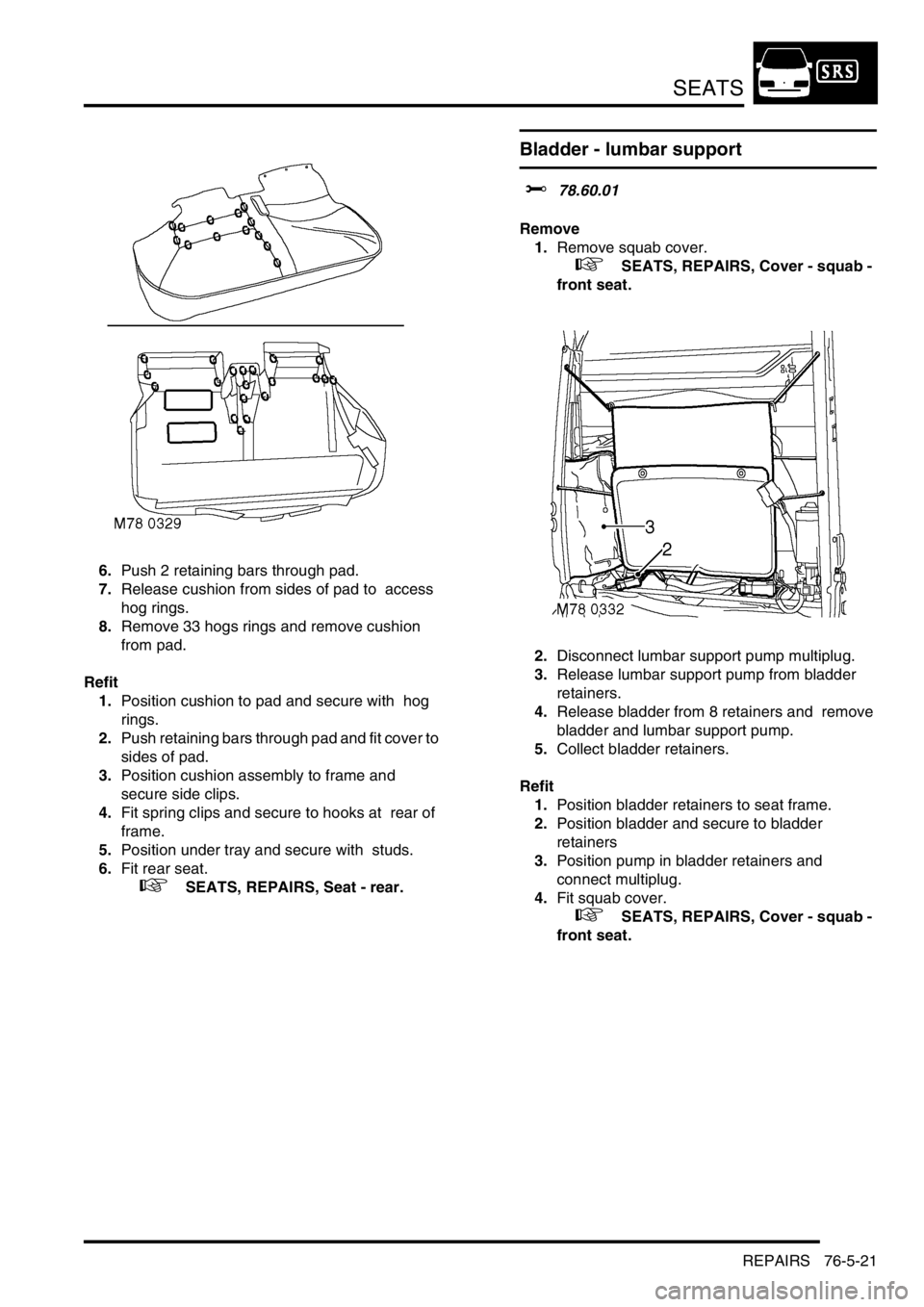2002 LAND ROVER DISCOVERY lumbar support
[x] Cancel search: lumbar supportPage 21 of 1672

CONTENTS
18 CONTENTS
Trim casing - 'D' post ..................................................................................................................... 76-3-3
Console - centre - automatic models .............................................................................................. 76-3-4
Console - centre - manual models .................................................................................................. 76-3-7
Fascia ............................................................................................................................................. 76-3-9
Panel - auxiliary switch ................................................................................................................... 76-3-13
Panel - fascia access - driver's side ............................................................................................. 76-3-14
Drink tray assembly - centre fascia................................................................................................. 76-3-14
Louvre panel assembly - centre fascia ........................................................................................... 76-3-15
Carpet - front................................................................................................................................... 76-3-17
Carpet - rear ................................................................................................................................. 76-3-18
Carpet - loadspace ........................................................................................................................ 76-3-19
Headlining ...................................................................................................................................... 76-3-20
Stowage pocket - front .................................................................................................................. 76-3-23
SCREENS ................................................................................................. 76-4-1
REPAIRS
Glass/sealing rubber - tail door ..................................................................................................... 76-4-1
Windscreen ................................................................................................................................... 76-4-2
Glass - body side - rear ................................................................................................................ 76-4-4
Glass - alpine light ........................................................................................................................ 76-4-6
SEATS ....................................................................................................... 76-5-1
DESCRIPTION AND OPERATION
Electric seat component location .................................................................................................... 76-5-1
Electric seat block diagram ............................................................................................................. 76-5-2
Description - electric seats.............................................................................................................. 76-5-4
Operation - electric seats ................................................................................................................ 76-5-7
DESCRIPTION AND OPERATION
Heated seat component location .................................................................................................... 76-5-9
Heated seat block diagram (electric seats).................................................................................... 76-5-10
Description - heated seats .............................................................................................................. 76-5-11
Operation - heated seats ................................................................................................................ 76-5-13
REPAIRS
Seat - front ..................................................................................................................................... 76-5-15
Seat - third row ............................................................................................................................... 76-5-16
Seat - rear ....................................................................................................................................... 76-5-18
Cover - cushion - front seat .......................................................................................................... 76-5-18
Heating element - cushion - front seat .......................................................................................... 76-5-20
Cover - cushion - rear seat ........................................................................................................... 76-5-20
Bladder - lumbar support .............................................................................................................. 76-5-21
Motor - fore and aft - front seat ..................................................................................................... 76-5-22
Motor - rise and fall - front seat ..................................................................................................... 76-5-23
Motor - tilt - front seat .................................................................................................................... 76-5-23
Motor - recline ................................................................................................................................. 76-5-24
Switch - electric seats .................................................................................................................... 76-5-24
Cover - squab - front seat ............................................................................................................. 76-5-25
Cover - squab - RH rear seat ........................................................................................................ 76-5-28
Heating element - squab - front seat ............................................................................................ 76-5-29
Head restraint - third row seat ....................................................................................................... 76-5-30
Page 1186 of 1672

SEATS
DESCRIPTION AND OPERATION 76-5-1
SEATS DESCRIPTION AND OPERAT ION
Electric seat component location
RHD shown, LHD similar
1BCU
2Drivers door switch
3Power relay
4Satellite fuse box
5Switch pack
6Fore/aft motor
7Cushion front up/down motor
8Cushion rear up/down motor
9Squab fore/aft motor
10Lumbar support bladder
11Lumbar pump
Page 1189 of 1672

SEATS
76-5-4 DESCRIPTION AND OPERATION
Description - electric seats
General
All markets use the same electric seat system. Electically operated lumbar support is optional. The system consists
of an electrical sub-system and a mechanical sub-system.
The electrical sub-system consists of the following components:
lBCU.
lSeat power relays.
lSeat switch packs.
lSeat fore/ aft motors.
lSeat cushion front up/ down motors.
lSeat cushion rear up/ down motors.
lSeat squab motor.
lLumbar pump.
lLumbar deflate solenoid.
The mechanical sub-system consist of the following components:
lGear wheels.
lRack and pinion assemblies.
Seat power relay
Located beneath the seat, the seat power relay supplies battery voltage to the satellite fuse box. Operation of the
relays is controlled by the BCU.
Voltage to the seat power relays is from fuse 5 in the engine compartment fuse box. The BCU controls the earth for
the relay coils. Operating the seat power relays provides voltage to the satellite fuse box under each seat.
Satellite fuse box
Located beneath the seat, the satellite fuse box provides circuit protection for the wiring to the seat switches and
motors. It also protects the lumbar inflate and deflate circuits.
The seat power relay provides voltage directly to the 40A fuse in the satellite fuse box. Voltage from this fuse feeds
the seat switch pack. The 3A fuses in the satellite fuse box protect the wiring to the lumbar pump and lumbar deflate
solenoid. Voltage to the 3A fuses comes from the seat switch pack.
Page 1191 of 1672

SEATS
76-5-6 DESCRIPTION AND OPERATION
Two pins within the seat switch pack control the seat fore/ aft motor. Both pins are normally earthed. Operating the
backward switch applies voltage to that pin while the other pin remains earthed. Operating the forward switch reverses
power and earth to the motor allowing the motor to run in the opposite direction.
Seat cushion front up/ down motor
The seat cushion front up/ down motor is a permanent magnet motor coupled to a rack and pinion assembly. Should
the motor seize or stick for 6 seconds or more an internal thermal cut out switch will trip to remove voltage from the
motor. Reset time for the switch is 35 seconds.
Two pins within the seat switch pack control the seat cushion front up/ down motor. Both pins are normally earthed.
Operating the up switch applies voltage to that pin while the other pin remains earthed. Operating the down switch
reverses power and earth to the motor allowing the motor to run in the opposite direction.
Seat cushion rear up/ down motor
The seat cushion rear up/ down motor is a permanent magnet motor coupled to a rack and pinion assembly. Should
the motor seize or stick for 6 seconds or more, an internal thermal cut out switch will trip to remove voltage from the
motor. Reset time for the switch is 35 seconds.
Two pins within the seat switch pack control the seat cushion rear up/ down motor. Both pins are normally earthed.
Operating the up switch applies voltage to that pin while the other pin remains earthed. Operating the down switch
reverses power and earth to the motor allowing the motor to run in the opposite direction.
Seat squab fore/ aft motor
The squab fore/ aft motor is a permanent magnet motor coupled to a rotary rack and pinion assembly. Should the
motor seize or stick for 6 seconds or more, an internal thermal cut out switch will trip to remove voltage from the motor.
Reset time for the switch is 35 seconds.
Two pins within the seat switch pack control the squab fore/ aft motor. Both pins are normally earthed. Operating the
fore switch applies voltage to that pin while the other pin remains earthed. Operating the aft switch reverses power
and earth to the motor allowing the motor to run in the opposite direction.
Lumbar pump
The lumbar pump inflates a bladder in the squab which provides extra support for the seat occupant. With no load on
the seat it takes approximately 10 seconds to completely inflate the bladder. With a load of 25 kg (55 lb) it takes
approximately 15 seconds to inflate the bladder. A pressure cut off switch in the system will operate at 0.12 to 1.93
bar (1.8 to 28 lbf.in
2). If a problem occurs with the lumbar bladder, e.g. a rupture, the whole lumbar system must be
replaced. The components are not serviceable.
Power comes from the seat switch pack through a 3A fuse in the satellite fuse box. The lumbar pump and the lumbar
deflate solenoid share an earth.
Lumbar deflate solenoid
The lumbar deflate solenoid vents the lumbar bladder to atmosphere to allow air to evacuate the bladder. The average
time to evacuate the bladder with a load of 25 kg (55 lb) is 9 seconds.
Power comes from the seat switch pack through a 3A fuse in the satellite fuse box. The lumbar deflate solenoid and
the lumbar pump share an earth.
Page 1192 of 1672

SEATS
DESCRIPTION AND OPERATION 76-5-7
Operation - electric seats
Seat power relay enable line
The BCU provides the seat power relays with an earth supply to the relay coil that enables the relay operation. When
this seat power relay enable line is active, the seat power relay energises allowing seat operation.
In order for the seat power relay to be active the BCU must detect either of the following condition options:
lIgnition switch in position II.
lIgnition switch in position II or driver's door within 45 seconds of opening.
Seat fore/ aft movement
When the cushion switch is operated and the seat power relay enable line is operating, power and earth are supplied
to the motor in the seat, allowing the seat to move forward or backward depending on switch position. The motor
drives a gear wheel along a gear rack connected to the seat base. Sliding the cushion switch forward causes the motor
to drive the seat forward. Sliding the cushion switch rearward reverses polarity of the voltage at the seat motor, driving
the seat rearward.
Seat cushion front up/ down movement
When the cushion switch is operated and the seat power relay enable line is operating, power and earth are supplied
to the motor in the seat, allowing the front of the seat cushion to move upward or downward depending on switch
position. The motor drives a gear wheel along a gear rack connected to the seat base. Sliding the front of the cushion
switch upward causes the motor to drive the seat upward. Sliding the front of the cushion switch downward reverses
polarity of the voltage at the seat motor driving the seat downward.
Seat cushion rear up/ down movement
When the cushion switch is operated and the seat power relay enable line is operating, power and earth are supplied
to the motor in the seat, allowing the seat to move upwards or downwards depending on switch position. The motor
drives a gear wheel along a gear rack connected to the seat base. Sliding the rear of the cushion switch upward
causes the motor to drive the seat upward. Sliding the rear of the cushion switch downward reverses polarity of the
voltage at the seat motor driving the seat downward.
Squab fore/ aft movement
When the squab switch is operated and the seat power relay enable line is operating, power and earth is supplied to
the motor in the squab, allowing the squab to move forward or backward depending on switch position. The motor
drives a gear wheel along a rotary gear rack connected to the squab. Sliding the squab switch forward causes the
motor to drive the squab forward. Sliding the squab switch rearward reverses polarity of the voltage at the seat motor
driving the squab rearward.
Lumbar inflate/ deflate
Sliding the squab switch upwards when the seat power relay enable line is operating applies voltage to the lumbar
pump. The lumbar pump inflates the lumbar bladder, increasing lumbar support. The lumbar pump and the normally
closed lumbar deflate solenoid hold the air in the bladder. Sliding the squab switch downwards applies voltage to the
deflate solenoid, venting the air in the lumbar bladder to atmosphere, decreasing lumbar support.
Diagnostics
TestBook can only verify that the seat power relay line is enabled. It cannot determine the status of the system or any
of the components.
Page 1206 of 1672

SEATS
REPAIRS 76-5-21
6.Push 2 retaining bars through pad.
7.Release cushion from sides of pad to access
hog rings.
8.Remove 33 hogs rings and remove cushion
from pad.
Refit
1.Position cushion to pad and secure with hog
rings.
2.Push retaining bars through pad and fit cover to
sides of pad.
3.Position cushion assembly to frame and
secure side clips.
4.Fit spring clips and secure to hooks at rear of
frame.
5.Position under tray and secure with studs.
6.Fit rear seat.
+ SEATS, REPAIRS, Seat - rear.
Bladder - lumbar support
$% 78.60.01
Remove
1.Remove squab cover.
+ SEATS, REPAIRS, Cover - squab -
front seat.
2.Disconnect lumbar support pump multiplug.
3.Release lumbar support pump from bladder
retainers.
4.Release bladder from 8 retainers and remove
bladder and lumbar support pump.
5.Collect bladder retainers.
Refit
1.Position bladder retainers to seat frame.
2.Position bladder and secure to bladder
retainers
3.Position pump in bladder retainers and
connect multiplug.
4.Fit squab cover.
+ SEATS, REPAIRS, Cover - squab -
front seat.